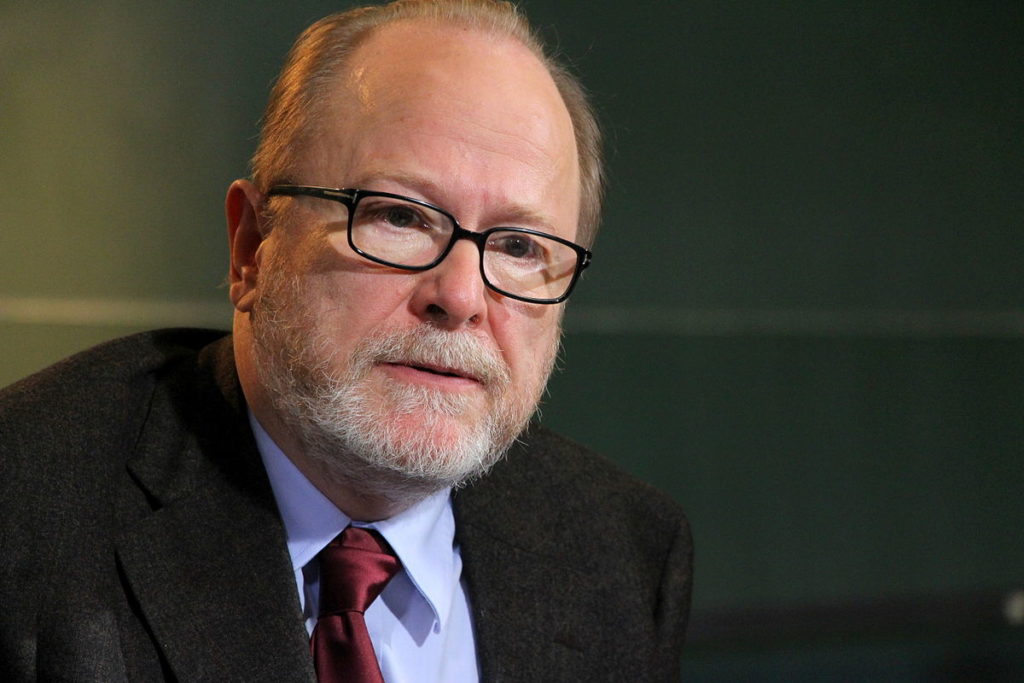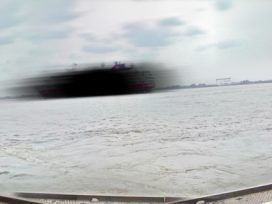The sun is setting; some last sails
Are making briskly for the harbour.
A good-sized boat in the canal
Will reach this quay at any moment.
Your coloured pennants flutter gaily,
Your masts and rigging show no damage –
The grateful sailor gives you thanks,
And fortune welcomes your well-timed return.
Ladies and Gentlemen, welcome to Hamburg. As you will know, these lines are from the second part of Goethe’s Faust. What sailing and sea-trade is all about you can hear from Mephistopheles’ reply:
We started out with two ships only,
But now we’re back in port with twenty.
Our cargo clearly demonstrates
What great success we have achieved.
On the open sea your mind is open,
And no one gives a fig for prudence;
You have to grab things in a hurry:
you catch a fish or catch a ship,
And once you’ve three in your possession,
You soon have caught a fourth as well;
The fifth then hasn’t got a chance,
Since it’s a fact that might is right –
Not how but what will be the only question asked.
Unless I’m all at sea about maritime matters,
War, trade, and piracy together are
A trinity not to be severed.
Another translation puts it this way:
The undivided trinity
Of war and trade and piracy.

Photo: Ziko van Dijk/ Wikipedia CC
In these lines Goethe expresses his fascination and mistrust of the sea-based economy. Not far from the economic graveyard that is the HafenCity is the place where the pirate Klaus Störtebeker was beheaded – you can see a statue of him there. This is also the city where ten Somali pirates are currently on trial. Again: welcome to Hamburg. And now for something completely different…
These days one often hears that Europe is in danger, but what does that nonsense mean? What may well be in danger is the way that some people (politicians, economists) would like to shape the idea of Europe, but ideas are never reality and are always in danger. Where did the idea of a Carolingian Europe die? At sea (Trafalgar)? On the battlefield of Waterloo? Or when the borders of the EU where extended eastwards? Is Europe a geographical idea and, if so, is it based on sea or soil ? Or is it a cultural space? You all know these questions and you all know that they can’t be answered and that one shouldn’t even try to do so. If you think it is vitally important to save the euro, it shouldn’t be because the idea of Europe will somehow be damaged if we don’t, but because the people living in Europe will be better of if the euro survives. No one is really about that, but in politics you have to go on – and you have to choose.
Helmut Kohl said that without the euro there would again be wars in Europe. I think he’s wrong. The Coal and Steel Community was a great achievement that pacified post-war Europe, but that doesn’t mean that anything short of a United States of Europe will return Europe to a state in which a loose conglomerate of states wages an internal war. Don’t misunderstand me: I’m not fond of the idea of the euro collapsing. But I do like the idea that, if it did, Europe would continue to be a place in which we like to live.
What gives me the confidence to think that way? Because Europe has become a cultural space that before it never was. Not because anyone wanted a “more European” culture – it just happened. And what just happens tends to be more resilient than what is overloaded by ideas and words, like shoes not properly shaped. Take Eurozine for example. It is what it is, in other words what the European magazines that are connected to it want it to be. Tomorrow’s Eurozine may be a better Eurozine than today’s – everyone tries to do things better in the future than he or she does now – and that shapes European culture a bit. Not because it fulfils any great idea, but because it’s good. It’s good because it’s intellectually ambitious, and a culture with intellectual ambitious is a fine environment to live in. If Europe’s not sea nor soil but culture, let’s understand “culture” thus: as intellectual ambition.
Intellectual ambition and seafaring – on the open seas your mind is open – came very close in the year 1769. I read to you a text by Arno Schmidt, one of the most important authors of post-war Germany, translated by John Woods. It is called:
A finer Europe
Commemorating our continent’s first great cooperative achievement
It happened long ago, and the initiative for unification came from anyone but politicians; it came from astronomy, of all the sciences the one that seems most removed from earth (though, of course, it had to pair itself with crude earthly interests).
Two hundred years ago, in fact, there was anything but clarity concerning the most fundamental astronomical measurement, on which all others depend – the distance from the earth to the sun. Today we know that it is 150 million kilometres; but even the great Kepler had guessed at about 30 million; circa 1750 the value fluctuated between 75 and 100.
And this apparently abstruse problem had its very serious practical side: as long as one did not know this most important constant, all calculations for orbits of the moon were doomed to uncertainty; and the moon was crucial if one wanted to determine the position of a ship at sea. The method was in such sad state that as late as 1742, Lord Anson, a famous world traveller, lost 80 men in a storm; for despite correct calculations, he could fix the position of his squadron only within a variance of 200 kilometres: and the island of Juan Fernandez, with its reefs, sandbanks, rocks, lay precisely that much nearer. This special problem had grown so pressing that the British government established a prize of 20,000 pounds sterling for a more precise means for determining one’s position – the equivalent in those penurious times of 10 million D=marks today! Something had to be done – but what?
There was one means by which to determine the fundamental constant of earth-sun. As early as 1677, there was a proposal by the English astronomer Halley (after whom one of the largest comets is still named today): it happens now and then that the planet Venus, located between the earth and the sun, crosses the solar disk as a little black dot; if, from various sites on earth, one measures the exact times of its entry and exit, by correlating the results one can determine the distance with great precision. Halley provided detailed rules of observation and the formulae for the calculation; nevertheless he was forced to conclude his paper with the brave=businesslike statement: “This constant of constants will first be determined long after I am dead.”
For that was the one obstacle to the application of this splendid method: “transits of Venus” are so rare that they occur only once every one hundred twenty years – when, however, there are two, one shortly after the other. Only once before had such a thing been observed, on 4 December 1639, and then purely by mistake. The next two transits would occur in 1761 and 69.
And so, for more than a century, people awaited the great event. It arrived, and – : yes; once again there was war in Europe and the world! In the Seven Years version, armies were on the move from France to Russia; and over in America, England was driving the French competition out of Canada.
Despite which, researchers did what was humanly possible; and the value was improved upon; but no definite, conclusive results were achieved. People looked to the future with gloomy foreboding! But at last it actually happened, or as the lovely ballad by Bürger puts it: “The empress and the king agreed, / their quarrel was too dreary, / and yielding now in mind and deed, / concluded: peace most cherry!” After 1763, with both diplomats and soldiers once again beneficially exhausted, the time had come for something more useful, more lofty.
And now commences the incomparably admirable and humanly inspiring spectacle of Europe’s first worldwide cooperative effort!
This rarest of events had been calculated to occur on 3 June 1769; but this sort of thing is never visible from the entire earth: after all, the sun must at least be above the horizon, there must be daylight, for its disk, and a superimposed Venus, to be observed. And so the task was to determine precisely those regions where the transit would be fully visible; that was the case in the far north of Europe, across all of northern Siberia, in most of the Pacific, as well as in the western half of North America. In the rest of Asia, the planet was visible only as it exited the solar disk; in western Europe and South America nothing but the entry was observable. Throughout Africa and the entire southern Atlantic sector the event remained invisible.
This, then was a new obstacle: the most important observation stations were needed, wouldn’t you know, in the most distant parts of the globe (and in those days you did not fly the Atlantic in a jet bomber in 4 hours!). But the united efforts of the European Republica Intelligentsia succeeded – by appealing in particular to the practical results to be expected – in winning the support of governments or well-situated individuals.
The king of Denmark invited the working staff of the Vienna Observatory to northern Norway; Sweden’s monarch offered the opportunity to travel to Finland. Katherine the Great paid out of pocket for additional instruments to be built by the most famous western workshops, and sent members of her Petersburg Academy out into the vast Russian empire: Rumovsky to Kola on the Arctic coast near Murmansk; Islennieff to far-off Yakutsk; Kraft to Orenburg; Euler to Orsk; instruments were directed heavenwards in Astrachan and Samarkand as well as in Lapland. France equipped expeditions: Chappé went to California; Pingré to San Domingo: le Gentil sailed for the Indian possession of Pondicherry; Bougainville was sent with a frigate to the Pacific. England fitted out ships: a man named Call was ordered to Madras. The Royal Geographic Society of London paid to dispatch Dymond and Wales to the western shore of Hudson Bay in the far north of Manitoba. And on 26 August 1768 – a year ahead of time, just so that it would arrive punctually ! – the Endeavour, three hundred seventy tons (!), captained by James Cook, left the port of Plymouth in order to convey the astronomer Green to Tahiti. (The realization that New Zealand and New Guinea were islands, as well as the mapping of the entire east coast of Australia were admirable secondary achievements). – One nation, let it be noted, excluded itself : Spain, the land without a Renaissance, where the project met with no interest – or as good as none.
For, as noted, these learned men had to set out a year ahead of time in the nutshells that passed for sailing ships at the time. They forged a path across two thousand kilometres, through howling Indian tribes, through damp=cold or =hot primeval forests; across icy raging streams; crossed the Siberian tundra in sleds; made the agonizing trip around Tierra del Fuego – and most were no longer that young; many had bushy beards turned gray in service to Urania.
The list of failures and disappointments seemed endless: Véron had left for the South Seas in 1768: all the same, delayed by contrary winds, he arrived too late, and he died in May 1770, far from home, of a broken heart: that does happen, even in the sciences! Chappé completed his task in California: 4 weeks later, he died of exhaustion from the journey. But if one could at least describe such an end to life as ideally=dramatic, elsewhere men met with what was simultaneously the most perfidious and the most banal of disappointments: bad weather! After months of perilous journeys there they stood, despondent, as if numbed, under hostile=heavy skies: in India, in Lapland. In some places it was merely “cloudy” – and with skittering hands they made the most of some few paltry minutes; perhaps a few of the notations might prove helpful after all. – The reports of the unique achievement read like the most exciting novel.
And the grand enterprise succeeded after all: at 5 places on the earth’s surface, under clear skies, people were able to observe the planet for the full 6 hours of its passage across the solar disk! At Vardøhus on the Arctic Ocean, Hell from Vienna measured by the midnight sun. Likewise Planmann from Stockhold at Kajaaniborg, in the vast forests of Finland. The third success was in northern Canada. The fourth along Mexico’s California coast; the last in Tahiti.
But now came the next delay before the great work could be completed and the distance to the sun finally known: it was a long trip home for the 5 observers; and there was no mail back then from the South Seas or the “barren grounds” at the magnetic pole. Paris, the leading city at the time in terms of the number of observatories and the renown of its learned men, had become the natural collecting point for all the material needed for the calculations; and so once the famous day of 3 June 1769 had passed, there they sat, waiting feverishly for the data. The Finnish measurements arrived first – of themselves of but partial value; only by combining them with other data could anything certain be said. In December of 69 the results came in from California. It was the end of March 1770 before the expeditions from Vardø and Hudson Bay returned. And not until September 1771, a full two years later, did the Endeavour slip into home port with the invaluable figures from Tahiti on board. –
The final calculations determined the long-sought value for the distance from earth to sun at between 145 and 155 million kilometres; after lengthy discussion of all the observations made, de Lalande, the leading French expert, decided on 153 – nowadays we use the internationally recognized value of 150. The error of only two per cent was quite inconsequential in comparison to earlier fantastic guesses. New, reliable tables for the planets were now possible. –
Six years previously they had been pointing not telescopes, but cannons at one another, these Russians; Prussians, English; Austrians; French (and soon thereafter they were back at the same old bloody game once again, and have kept it up to this very day!) But once at least people were united, and for the loftiest of goals: in 1769. On the third of June!
***
That is how Arno Schmidt described a Europe made finer by intellectual ambition and the needs of a maritime economy.
Jan Phillipp Reemtsma was addressing the 24th European Meeting of Cultural Journals, Hamburg, 14-16 September 2012. Read the full conference report here.








